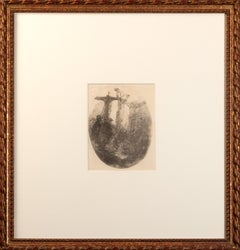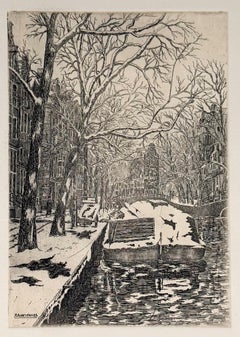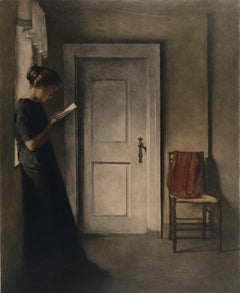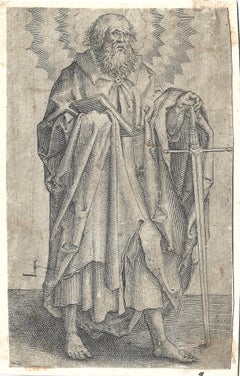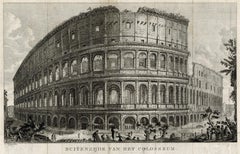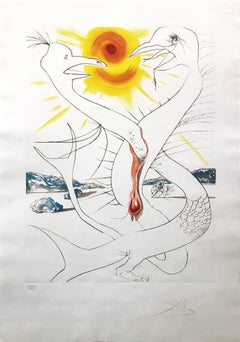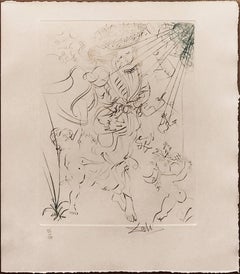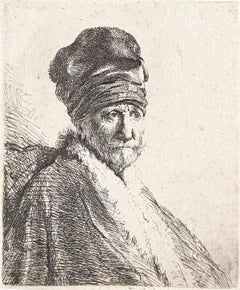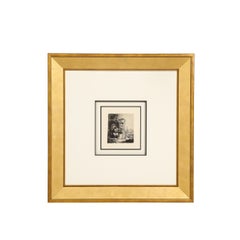Dutch School Figurative Prints
to
1
7
1
Overall Width
to
Overall Height
to
15,640
8,147
2,653
2,434
2,254
1,053
1,001
726
672
419
323
112
93
39
1
1
1
4
2
2
2
6
2
5
1
1
1
1
1
1
1
1
1
1
1
1
1
1
1
1
1
1
6
5
5
4
2
2
1
8
Style: Dutch School
17th century etching Rembrandt biblical scene crucifixion figures
Located in Milwaukee, WI
Rembrandt's print 'Christ Crucified Between Two Thieves: an oval plate' is one of the most captivating of the artist's oeuvre. Etched to an oval rather than a rectangular plate and t...
Category
1640s Dutch School Figurative Prints
Materials
Paper, Etching, Printer's Ink, Drypoint
Reguliersracht during winter, Amsterdam
Located in Middletown, NY
Etching with drypoint on cream wove paper with a deckle edge, 6 7/8 x 4 7/8 inches (200 x 125 mm); sheet 15 x 11 inches (380 x 280 mm), full margins. In excellent condition with mino...
Category
Early 20th Century Dutch School Figurative Prints
Materials
Drypoint, Etching
Interior with Red Shawl (Young woman reads in this calm Vermeer-like interior)
Located in New Orleans, LA
Interior with a red shawl conveys a quite different mood and feeling: one of calm, and suspension of time. Here the suggestion is that the woman is waiting ...
Category
Early 20th Century Dutch School Figurative Prints
Materials
Mezzotint
$5,625 Sale Price
25% Off
Saint Paul, from the series of Standing Saints
By Lucas van Leyden
Located in Middletown, NY
Engraving on cream laid paper laid down to wove paper, 4 1/4 x 2 5/8 inches (109 x 68), trimmed inside the platemark. Scattered discoloration and uniform age tone, all consistent wit...
Category
16th Century Dutch School Figurative Prints
Materials
Laid Paper, Engraving
Moulins de Hollande
Located in Middletown, NY
Etching on cream laid paper. 5 7/16x7 7/16 inches (137 x 188 mm). Scattered toning, age stain, and scattered minor defects consistent with age. Second state (of 3).
[Delteil 14]
Jo...
Category
19th Century Dutch School Figurative Prints
Materials
Laid Paper, Etching
Buitenzijde Van Het Colosseum (Exterior of the Colosseum)
Located in Middletown, NY
The Hague: circa 1799.
Engraving with burin on cream laid paper, 7 7/8 x 13 inches (198 x 330 mm) full margins. Octavo fold with additional hard creases with an associated loss in t...
Category
Late 18th Century Dutch School Figurative Prints
Materials
Laid Paper, Engraving
The Ship Builder and His Wife by Johannes Pieter de Frey
Located in Middletown, NY
Etching with engraving on cream laid paper which is watermarked with a fancy "M," 9 1/2 x 12 3/16 inches (240 x 308 mm), narrow margins. In good condition with some scattered light a...
Category
Early 19th Century Dutch School Figurative Prints
Materials
Laid Paper, Engraving, Etching
Bouquet of Flowers
By Cornelis Ploos van Amstel
Located in New York, NY
A supberb impression of this extremely scarce and early color etching after Jan van Huysum. With the artist's ink stamp.
Category
1770s Dutch School Figurative Prints
Materials
Color, Etching
Related Items
THE CADUSEUS OF MARS NOURISHED BY THE BALL OF FIRE OF JUPITER
Located in Aventura, FL
Hand signed and numbered in pencil. From the series La Conquete du Cosmos (Conquest of Cosmos). Authenticated by Albert Field on verso. Sheet siz...
Category
1970s Dutch School Figurative Prints
Materials
Engraving, Lithograph, Paper
$3,750 Sale Price
25% Off
H 38.5 in W 27.5 in
AUTUMN
Located in Aventura, FL
Hand signed and numbered by the artist. First edition engraving with color. Edition 97/150. Sheet size: 14 x 12.25 inches. Image size 10.43 x 7.95 inches. Custom framed as pictured...
Category
1970s Dutch School Figurative Prints
Materials
Paper, Engraving
Early 20th Century British Street Scene - 1920s Figurative Landscape Etching
By E. Mary Shelley
Located in Soquel, CA
Highly detailed figurative landscape lithograph of a street in London with a towering cathedral, old buildings, and figures walking the street below by E. Mary Shelley (English, late...
Category
1920s Dutch School Figurative Prints
Materials
Paper, Etching
$440 Sale Price
20% Off
H 15 in W 11 in D 0.13 in
CAMELOT
Located in Aventura, FL
Etching on paper. Hand signed, titled and numbered by the artist. Sheet size 12 x 10 inches. Image size 7 x 4.75 inches. Edition of 300. Artwork is in excellent condition. Certi...
Category
Late 20th Century Dutch School Figurative Prints
Materials
Paper, Etching
Figurative Etching of Two Girls in Gowns, Line Drawing
By Dorian Krausz
Located in Soquel, CA
Delicate drypoint etching of two girls by Dorian Krausz (American, b. 1948). Signed "Dorian Krausz" in the lower right corner. Numbered "196/300" in the lower left corner. Presented ...
Category
Late 20th Century Dutch School Figurative Prints
Materials
Paper, Ink, Drypoint
$372 Sale Price
20% Off
H 14 in W 11 in D 0.25 in
"King of the Friendly Islands" (Tonga); Engraving from Captain Cook's 3rd Voyage
By John Webber
Located in Alamo, CA
"Poulaho, King of the Friendly Islands, Drinking Kava" is an engraving created by William Sharp (1749-1824), from a drawing by John Webber (1752-1793), who was the artist on Captain James Cook's 3rd and final voyage of discovery. It was published in the atlas of "A Voyage to the Pacific Ocean Undertaken by the Command of His Majesty, for Making Discoveries in the Northern Hemisphere", the official British Admirality sanctioned journal published upon completion of the voyage in London in 1784 by Strahan & Cadell.
Captain Cook visited Tonga on his 3rd voyage, which he named The Friendly Islands because of the warm welcome he and his crew received, unlike some of the other more hostile Pacific islands. The engraving depicts Cook and his men observed a kava ceremony at the village of Mu’a on Tongatapu. King Paulaho sits in the centre foreground, his back to the spectator with a man kneeling before him. The ceremonial mat depicted behind Paulaho indicates that nobody was allowed to sit behind him. The figure in the centre holds a single cup, referring to the Tongan custom of offering the cup to the king first. Kava is native to the islands of the South Pacific and was first described for English readers in 1768 by Captain James Cook. The kava root has been used for centuries as a central feature of ceremonies and celebrations because it was able to bring about a calming and pleasant social atmosphere. The root was crushed and processed into coconut milk to become the focal ceremonial beverage, simply referred to as kava.
This engraving is presented in a Koa wood frame and a white mat. Koa wood is legendary in Hawaii. There are occasional faint spots, but the print is otherwise in very good condition. This amazing Koa wood is native to Hawaii and it is known for the deep rich colors and varied grain pattern. Koa has an honored heritage in Hawaii and is highly revered and sacred. The word “koa” means “warrior” in Hawaiian. The warriors of King Kamehameha the Great, created canoes and weapons from a wood plentiful on the Big Island of Hawaii. This wood became synonymous with the warriors themselves, and it became known as koa.
There are three other engravings listed from the official journal of Captain Cook's 3rd voyage available that are presented in identical Koa wood frames and mats (LU117324682422, LU117324684052, LU117324684032). They would make a wonderful grouping for a display of 2, 3 or 4 prints. A discount is available for a grouping depending on the number of items included.
Captain Cook is remembered as one of the greatest explorers and navigators in history. His explorations included Australia, New Zealand and islands of the South Pacific and the northwest coast of North America. Hawaii was discovered by Captain Cook during this voyage. Hawaii was originally called The Sandwich Islands in honor of The Earl of Sandwich...
Category
1780s Dutch School Figurative Prints
Materials
Engraving
$2,375
H 18.25 in W 23.5 in D 0.88 in
"Mother" 2004 original signed engraving etching limited edition print Cuban art
Located in Miami, FL
Eduardo ¨Choco¨ Roca Salazar (Cuba, 1949)
'Mother II ', 2004
dry point on paper Guarro Super Alpha 250g.
19.3 x 15.4 in. (49 x 39 cm.)
Edition of 20
Unframed
ID: CHO-112_1
Hand-sign...
Category
Early 2000s Dutch School Figurative Prints
Materials
Ink, Engraving, Etching
"End of Day" Original Limited Edition Etching
Located in Soquel, CA
"End of Day" Original Limited Edition Etching by John McGrath (Irish/American b.1884 d.1942).
This etching depicts a man with a tool slung over his shoulder walking along a path th...
Category
Early 20th Century Dutch School Figurative Prints
Materials
Paper, Ink, Drypoint, Etching
Red Grooms, Mr. Chuck Berry, color silkscreen with 3-D collage, signed/n framed
By Red Grooms
Located in New York, NY
Red Grooms
Mr. Chuck Berry, 1978
Original silkscreen in colors with 3D construction and die-cut collage on paper
Signed and numbered 9/25 AP in graphite pencil on the front
Pencil si...
Category
1970s Dutch School Figurative Prints
Materials
Mixed Media, Screen, Laid Paper
$2,000
H 38 in W 31 in D 1.25 in
Tigre couché à l'entrée de son antre (Tiger Lying at the Entrance to its Lair)
Located in Middletown, NY
Etching, drypoint, and roulette on watermarked Hallines cream laid paper, 3 3/4 x 5 7/8 inches (95 x 148 mm), full margins. A very good impression of this charming image, with all of...
Category
Early 19th Century Dutch School Figurative Prints
Materials
Laid Paper, Drypoint, Etching
'Jesus and the Woman at the Well, ' by Amand-Durand, Engraving
By Armand Durand
Located in Oklahoma City, OK
This early 19th century framed 35" x 31" engraving by artist Amand-Durand depcits an etching of 'Jesus and the Woman at the Well,' after the Dutch master, Rembrandt van Rijn. This poignant Biblical story is depicted by Arman-Durand in Rembrandt style...
Category
Early 19th Century Dutch School Figurative Prints
Materials
Engraving
$1,200 Sale Price
20% Off
H 30.5 in W 26.5 in D 1.5 in
"Conception" - Portrait of a Native American on a Vision Quest
Located in Soquel, CA
"Conception" - Portrait of a Native American on a Vision Quest
Large scale and fine detailed work by the artist. Detailed and evocative depiction of a Native American elder by Frank Howell...
Category
1990s Dutch School Figurative Prints
Materials
Laid Paper, Screen
$3,080 Sale Price
20% Off
H 56.75 in W 42.75 in D 1.5 in
Previously Available Items
Bust of a Man Wearing a High Cap, Three-Quarters Right (The Artist's Father ?)
Located in New York, NY
A very good, dark impression of this etching, with strong contrasts and little to no sign of wear. Biörklund's second state (of 2); Usticke's fifth state (of 7); New Hollstein's sixt...
Category
1630s Dutch School Figurative Prints
Materials
Etching
Rembrandt, Christ and the Woman of Samaria, Among Ruins
Located in New York, NY
This stunning etching was realized by the baroque master Rembrandt van Rijs in Holland, 1634. The composition pictures Jesus Christ with a hand outstretched, identified with his long flowing locks, donning a robe with a his hand outstretched as he addressed the female figure next to him. The lady holds the well chain with the bucket of freshly drawn water resting on the edge of the cobbled rock well. The lady looks on in rapt attention, one hand resting on the crumbling edge of a embankment. In the background there are a series of archways, and two men in the midst of gossiping (perhaps at the sight of Jesus). Rembrandt executed the etching in delicate chiaroscuro that masterfully illustrates the light, perspective and emotion of the scene as only he is able to. The work depicts Jesus Christ and the woman of Samaria recalling the passage from the biblical verse John 4:5-30 in which Jesus speaks to a peasant Samaritan woman fetching water from a well. "There came a woman of Samaria to draw water. Jesus said to her, 'Give me a drink.' For his disciples had gone away into the city to buy food. The Samaritan woman said to him, 'How is it that you, a Jew, ask a drink of me, a woman of Samaria?' For Jews have no dealings with Samaritans. The parable demonstrates Jesus' kind regard for all peoples regardless of social stature. With its elegant composition and incredible artistry (by one of the most influential and celebrated artists of all time), this work promises to delight discerning collectors of historically important works. It represents a winning acquisition for lovers of fine art (especially those with an interest in first rate Renaissance works), and also those with a penchant for religious and biblical art...
Category
17th Century Dutch School Figurative Prints
Materials
Etching
H 24 in W 23 in D 2.5 in
Solomon's Idolatry
By Lucas van Leyden
Located in New York, NY
An excellent boldly-inked impression of this scarce engraving by van Leyden. Trimmed on the plate mark.
Category
16th Century Dutch School Figurative Prints
Materials
Engraving
Dutch School figurative prints for sale on 1stDibs.
Find a wide variety of authentic Dutch School figurative prints available for sale on 1stDibs. Works in this style were very popular during the 20th Century, but contemporary artists have continued to produce works inspired by this movement. Many Pop art paintings were created by popular artists on 1stDibs, including Johan Barthold Jongkind, Rembrandt van Rijn, and Cornelis Ploos van Amstel. Frequently made by artists working with Engraving, and Etching and other materials, all of these pieces for sale are unique and have attracted attention over the years. Not every interior allows for large Dutch School figurative prints, so small editions measuring 0.44 inches across are also available. Prices for figurative prints made by famous or emerging artists can differ depending on medium, time period and other attributes. On 1stDibs, the price for these items starts at $250 and tops out at $13,800, while the average work sells for $1,650.
Still Thinking About These?
All Recently ViewedMore Ways To Browse
Edward Simmons
Edwin Lord Weeks
Elizabeth Enders
Elizabeth Horning
Emil Holzhauer
England Church Oil Painting
English Deer Painting
English Fox Hunt Painting
English Toy Terrier
Enrique Martinez Celaya
Eric Aho
Eritrea Art
Ernest Chateignon
Erotic Art Animal
Eugene Chigot
Eugene Devaud De Madelin
Eugene Jardin
Faith Sheppard
